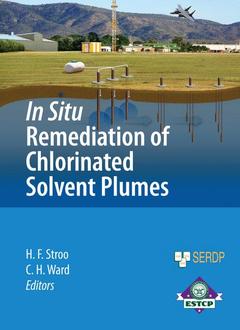Description
In Situ Remediation of Chlorinated Solvent Plumes, 2010
SERDP ESTCP Environmental Remediation Technology Series
Coordinators: Stroo Hans F., Ward C. Herb
Language: English
Subjects for In Situ Remediation of Chlorinated Solvent Plumes:
In Situ Remediation of Chlorinated Solvent Plumes
Publication date: 08-2016
Support: Print on demand
Publication date: 08-2016
Support: Print on demand
In situ remediation of chlorinated solvent plumes (SERDP-ESTCP Environmental remediation technology)
Publication date: 09-2010
786 p. · 19.3x26 cm · Hardback
Publication date: 09-2010
786 p. · 19.3x26 cm · Hardback
Description
/li>Contents
/li>Comment
/li>
In the late 1970s and early 1980s, our nation began to grapple with the legacy of past disposal practices for toxic chemicals. With the passage in 1980 of the Comprehensive Envir- mental Response, Compensation, and Liability Act (CERCLA), commonly known as Sup- fund, it became the law of the land to remediate these sites. The U. S. Department of Defense (DoD), the nation?s largest industrial organization, also recognized that it too had a legacy of contaminated sites. Historic operations at Army, Navy, Air Force, and Marine Corps facilities, ranges, manufacturing sites, shipyards, and depots had resulted in widespread contamination of soil, groundwater, and sediment. While Superfund began in 1980 to focus on remediation of heavily contaminated sites largely abandoned or neglected by the private sector, the DoD had already initiated its Installation Restoration Program in the mid-1970s. In 1984, the DoD began the Defense Environmental Restoration Program (DERP) for contaminated site assessment and remediation. Two years later, the U. S. Congress codified the DERP and directed the Secretary of Defense to carry out a concurrent program of research, development, and demonstration of innovative remediation technologies. As chronicled in the 1994 National Research Council report, ?Ranking Hazardous-Waste Sites for Remedial Action,? our early estimates on the cost and suitability of existing techn- ogies for cleaning up contaminated sites were wildly optimistic. Original estimates, in 1980, projected an average Superfund cleanup cost of a mere $3.
Groundwater Contamination by Chlorinated Solvents: History, Remediation Technologies and Strategies.- Chlorinated Solvent Chemistry: Structures, Nomenclature and Properties.- Biodegradation of Chlorinated Ethenes.- Abiotic Processes Affecting the Remediation of Chlorinated Solvents.- Engineering and Implementation Challenges for Chlorinated Solvent Remediation.- Modeling Remediation of Chlorinated Solvent Plumes.- Impacts of Source Management on Chlorinated Solvent Plumes.- DNAPL Site Characterization Issues at Chlorinated Solvent Sites.- Remedial Technology Selection for Chlorinated Solvent Plumes.- Bioremediation of Chlorinated Solvent Plumes.- Monitored Natural Attenuation of Chlorinated Solvent Plumes.- Biostimulation for Anaerobic Bioremediation of Chlorinated Solvents.- Bioaugmentation for Anaerobic Bioremediation of Chlorinated Solvents.- Air Sparging for the Treatment of Chlorinated Solvent Plumes.- Chemical Oxidation and Reduction for chlorinated Solvent Remediation.- Iron Barrier Walls for Chlorinated Solvent Remediation.- Electrolytic Reactive Barriers for Chlorinated Solvent Remediation.- In-Well Treatment for Chlorinated Solvent Remediation.- Phytoremediation of Chlorinated Solvent Plumes.- Cost Analyses for Remedial Options.- Future Directions and Research Needs for Chlorinated Solvent Plumes.
The editors and chapter authors have produced a well-written and up-to-date treatise that we hope will prove to be a useful reference for those making decisions on remediation of chlorinated solvents, for remediation practitioners, and for those involved in development of advanced technology for the in situ remediation of dissolved chlorinated solvents in groundwater Includes supplementary material: sn.pub/extras
© 2024 LAVOISIER S.A.S.




